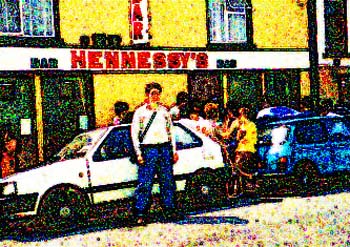THE EDINBURGH FIDDLE STYLE
As we all know - there are a thousand and one ways to play the folk fiddle.
Beautiful
folk playing with ornate bowing patterns though comes with a price - for
when it comes to directly translating your intuition into other idioms
such as rock or blues, jazz or improvisation behind songs - the brain has
to work very hard to break the constraints - which are imposed by
traditions.
A
fiddle style without constraints then is what this system is about
The
Edinburgh System has 8
factors:
1.
Dynamics
2.
Percussion
3.
Slide
4.
Bend
5.
Stopping/Chording
6.
Ornamentation
7.
Harmony/counterpoint
8.
Combinations
Many of these assets are missing from today's traditional approach, some even frowned upon - but these 8 skills will take the traditional player into explorations of genres and idioms that are closed to the average Traditionalist.
You
can hear me develop the genre with my album called ECLECTIC FIDDLE and
its at http://www.lulu.com/content/813978
It
can transpose easily into the electric fiddle genre and can be applied to
the playing of guitar solos and backing in 50's-90's covers, or jazz and
blues numbers.
It
has also enabled me to explore the world of electronic dance music as well
as Ceilidh.
1. DYNAMICS - soft, loud, fast and slow are taught in orchestras but
seldom applied in traditional sessions - punctuation and interpretation
are vital to the music of any idiom and also vital to recognize that good accompaniment behind vocals often requires the absence of
sound and the presence of space.
2. PERCUSSION - use of dynamic bowing and chording to produce percussive
chords and sounds that emphasize or counterpoint the melody. The wood of the bow if carefully controlled
and if the tension of the bow hair is appropriate - can be used to hit the strings at the top of the
fingerboard. Electric Violin can also benefit from this especially if
there is an effects patch used.
Also
electric violin firing through eg. distortion or delay can sound very
weird and strange when the bow is dragged very very slowly - where the bow
hair grates in a controlled way whilst applying even pressure.
This
effect can sound very eerie
3. SLIDE - the use of slide can give a note a very produced feel - where
if you listen closely the tonal qualities produced by the slide [as long
as you know or can hear where to stop the pitch shift] Slide can be done
badly - sometimes too slowly - sometimes too fast - but it must be in
accord with the rhythm or breathing in the melody. There is much more time
between notes than we really realize.
4. BEND - bend is a two way slide - very useful for imitating trad
flute, blues harp or electric guitar. focusing on the swell, build and decay of the note means that you must try to
listen carefully - sometimes just a roll or movement of the fingertip.
Vibrato
comes into this category but perhaps this is a more contemporary use of
the mechanism. Bending can add a transparency and feel to your sound.
5.
STOPPING/CHORDING - most of the popular keys used in covers, trad and rock
and rhythm and blues enable us to make use of the
5ths tuning of the violin.
simple
2 or 3 note drones or chords can help add gusto to any repeat.
6. ORNAMENTATION - there are various approaches to ornamentation that
will be illustrated - and it must be emphasized that rather than one fixed way of playing them - there are several
ideas bundled up into a freer and looser approach.
7. HARMONY & COUNTERPOINT - causes problems at
traditionalist sessions but essential for arrangements - many people say
that improvisation cannot be taught - well I largely disagree on that one
- there simply needs to be a clear picture in the mind of the fiddler what
the basic root notes and arpeggios are.
8. COMBINATIONS - the combination of all of the above is rather
like learning a language sliding and chording at the same time - or
percussive ornamentations, or bend with dynamics - the combined use of all
of these components makes the fiddle a more expressive and adaptable
instrument and can ultimately lead to much more professional options than
some of the beautiful traditional but often monotonous 'wallpaper' we
hear.
***********************************************************************************
The Edinburgh Fiddle Style is a rich means of expression that can be transported into any contemporary or traditional idiom.
With slides and stops and various lengths of ornamentation - with all eight components of the Edinburgh Fiddle Style working together you may not get that purist Traditional gig - but then you are part of the evolving and living folk and world tradition with its eclectic, adaptable and improvisational approach to many different styles.
Eclectic
hand to hand Adaptation is essentially more Scottish or Irish than any
style set in stone - in my opinion.
Many
of us learned to play orchestral violin at school then ended up feeling
sickened by the boring and mindless schooling of the Minuet in G or Ode on
a G String.
Thousands
of people give up the violin because its no fun – it’s either the
teachers way or the highway and we end up breaking our non conformist
wrists and elbows because our bodies and hands don't appear to be the
right shape.
So
school violin not being much if any fun is ditched at the first
opportunity either for a guitar or drum machine or even a much better
life.
This
contemporary fiddle style will put those School torments to much greater
use than you could imagine - for its actually better if you don't have a
traditionalist approach ingrained.
Transform
your experience of the Violin from 'Torment in G sharp with lines after
school' to rock and roll
solos where you can really feel the force of your deep down boogie.
